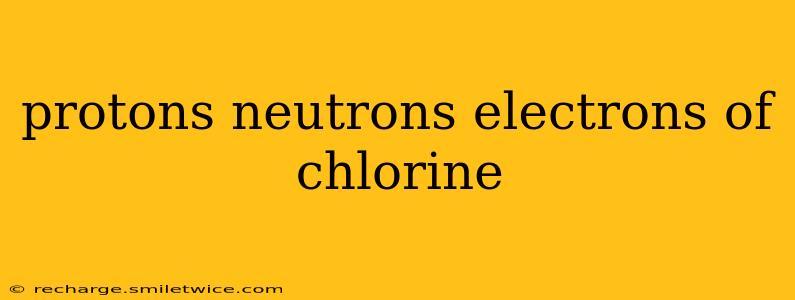Chlorine, a vital element in our daily lives, plays a crucial role in everything from disinfecting water to producing plastics. Understanding its atomic structure, specifically the number of protons, neutrons, and electrons, is key to grasping its chemical behavior and properties. This article will delve into the specifics of chlorine's atomic composition, addressing common questions and providing a comprehensive overview.
How many protons, neutrons, and electrons does chlorine have?
Chlorine (Cl) has an atomic number of 17. This means that a neutral chlorine atom contains 17 protons. Since atoms are electrically neutral, the number of protons (positively charged) must equal the number of electrons (negatively charged). Therefore, a neutral chlorine atom also has 17 electrons.
The number of neutrons, however, varies depending on the isotope of chlorine. The most common isotopes are chlorine-35 (³⁵Cl) and chlorine-37 (³⁷Cl).
- Chlorine-35 (³⁵Cl): This isotope has 18 neutrons (35 - 17 = 18). It makes up approximately 76% of naturally occurring chlorine.
- Chlorine-37 (³⁷Cl): This isotope has 20 neutrons (37 - 17 = 20). It constitutes about 24% of naturally occurring chlorine.
Therefore, while the number of protons and electrons are fixed at 17, the number of neutrons can be either 18 or 20.
What is the atomic mass of chlorine?
The atomic mass of chlorine is not a whole number because it's a weighted average of the masses of its isotopes. The weighted average reflects the relative abundance of each isotope. The standard atomic mass of chlorine is approximately 35.45 atomic mass units (amu).
How many electrons are in each shell of chlorine?
Chlorine's electrons are distributed across three electron shells:
- Shell 1: Contains 2 electrons.
- Shell 2: Contains 8 electrons.
- Shell 3: Contains 7 electrons.
This electron configuration (2, 8, 7) explains chlorine's high reactivity. It readily gains one electron to achieve a stable octet (8 electrons) in its outermost shell, forming a chloride ion (Cl⁻).
What is the electron configuration of chlorine?
The electron configuration of chlorine is 1s²2s²2p⁶3s²3p⁵. This notation specifies the energy levels and sublevels occupied by the electrons.
Why is chlorine important?
Chlorine's unique properties make it crucial in various applications:
- Water purification: Chlorine is widely used to disinfect drinking water and swimming pools, effectively eliminating harmful bacteria and pathogens.
- Industrial processes: It's a key component in the production of various chemicals, including plastics (PVC), solvents, and pesticides.
- Medical applications: Certain chlorine compounds have medicinal uses, though others are highly toxic.
What are the isotopes of chlorine?
As mentioned earlier, the two main isotopes of chlorine are chlorine-35 and chlorine-37. These isotopes differ only in the number of neutrons, but this difference impacts their mass and, to a lesser extent, their properties.
This comprehensive overview covers the fundamental aspects of chlorine's protons, neutrons, and electrons. Understanding these atomic features is fundamental to understanding its chemical reactivity and its widespread applications in diverse fields.
